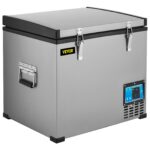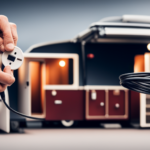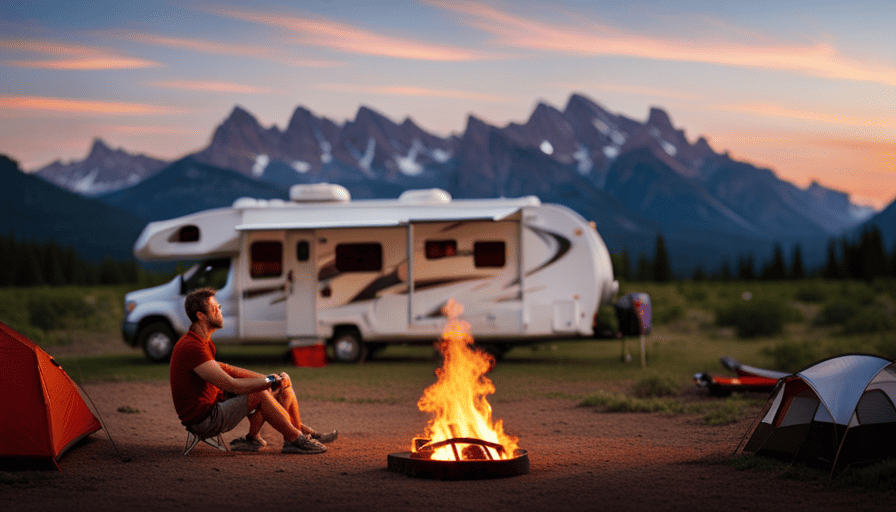Have you ever experienced the frustration of being completely in the dark after connecting your camper, only to discover there is no power?
It’s like having a key to a treasure chest, but the chest won’t open.
Well, fear not fellow campers, for we are here to shed light on this perplexing problem.
In this article, we will delve into the world of troubleshooting and explore the possible reasons behind the lack of power when your camper is plugged in.
From checking the power source and inspecting the power cord to testing the circuit breakers and examining the fuse box, we will leave no stone unturned in our quest to solve this electrical enigma.
So, grab your tools and get ready to dive into the heart of the issue.
Together, we will uncover the secrets of restoring power to your beloved camper.
Key Takeaways
- Troubleshooting steps can help identify the cause of no power when plugging in a camper, such as checking the power source, circuit breakers, and fuse box.
- Inspecting the power cord for damage and ensuring proper connections can help determine if it needs to be replaced.
- Checking battery connections for corrosion and verifying voltage levels can help identify potential issues.
- Consulting a professional for accurate diagnosis and seeking expert advice for complex electrical systems is recommended.
Check the Power Source
You’ll want to make sure you’ve checked the power source to see if that’s the reason why there’s no power to your camper when it’s plugged in. Troubleshooting steps for this issue include verifying that the power source is functioning correctly and ensuring that there are no common issues that could be causing the problem.
First, check if the power source is supplying electricity. This can be done by using a voltage meter to test the outlet or by plugging in a different device to see if it receives power. If the power source is not providing electricity, you may need to reset the circuit breaker or contact an electrician to resolve any wiring issues.
Common issues that can cause a lack of power to the camper include a tripped circuit breaker, a blown fuse, or a faulty power outlet. Inspect the circuit breaker panel and replace any blown fuses if necessary. Additionally, check the power outlet for any signs of damage or loose connections.
Once you’ve completed these troubleshooting steps and ruled out any power source issues, it’s time to inspect the power cord.
Inspect the Power Cord
When inspecting the power cord, check for any visible damage or frayed wires. A damaged power cord can prevent power from reaching the camper, so it’s essential to ensure its integrity.
Here are some steps to troubleshoot the power cord:
-
Visually inspect the cord: Look for any signs of wear and tear, such as cuts, abrasions, or exposed wires. If you notice any damage, it’s crucial to replace the power cord promptly.
-
Check the connectors: Examine both ends of the power cord where it plugs into the camper and the power source. Make sure the connectors are clean, free from corrosion, and properly connected.
-
Test for continuity: Using a multimeter, check for continuity along the entire length of the power cord. This’ll help identify any breaks or short circuits in the wiring.
-
Verify the voltage: Measure the voltage at the power source and ensure it matches the requirements of your camper. Low voltage can affect the camper’s power supply.
If you find any issues during the inspection, replace the power cord to ensure a reliable power connection.
Now, let’s move on to the next step and test the circuit breakers.
Test the Circuit Breakers
Next, it’s time to check if the circuit breakers are working properly. When troubleshooting the power issue in your camper, it’s important to examine the circuit breakers as they play a crucial role in protecting the electrical system from overload.
Start by locating the circuit breaker panel, which is usually found in a convenient location inside the camper. Open the panel to access the circuit breakers. Inspect each breaker to ensure that none of them are tripped or in the off position. If you find any breakers that have tripped, simply flip them back to the on position.
It’s also important to check for any loose connections or damaged wiring around the breaker panel. Common issues that can cause the circuit breakers to trip include overloading the system by using too many electrical appliances simultaneously or a short circuit in the wiring.
Once you have checked the circuit breakers and made any necessary adjustments, you can proceed to examine the fuse box for further troubleshooting.
Examine the Fuse Box
Now, it’s time to take a look at the fuse box to determine if it’s functioning correctly. The fuse box is an essential component of the camper’s electrical system, as it protects the circuits from electrical overloads.
To troubleshoot any issues with the fuse box, follow these techniques.
First, visually inspect the fuse box for any signs of damage or loose connections. Make sure that all fuses are properly seated and not blown. If you notice a blown fuse, replace it with a new one of the same amperage rating.
Next, check for any corrosion or rust on the fuse box terminals. Use a wire brush to clean the terminals and ensure a good connection. If the terminals are severely corroded, it may be necessary to replace the fuse box.
Another common issue with the fuse box is a faulty fuse holder. Test the fuse holders by gently wiggling them to see if they’re loose. If a fuse holder is loose or not holding the fuse securely, replace the holder.
By troubleshooting the fuse box using these techniques, you can identify and resolve common issues that may be causing a lack of power to the camper.
Now, let’s move on to the next section and check the battery connections.
Check the Battery Connections
To ensure optimal performance of your camper, make sure to check the battery connections. The first step is to visually inspect the battery terminals for any signs of corrosion or loose connections. Corrosion can inhibit the flow of electricity and prevent power from reaching your camper. If you notice any corrosion, it’s important to clean the terminals thoroughly using a wire brush and a solution of baking soda and water. After cleaning, make sure the connections are tight and secure.
In addition to checking the physical connections, it’s also important to verify the battery voltage. You can do this using a multimeter or a voltmeter. Simply connect the positive lead of the voltmeter to the positive terminal of the battery and the negative lead to the negative terminal. A fully charged battery should read around 12.6 volts. If the voltage is significantly lower, it may indicate a problem with the battery itself.
Once you have checked the battery connections and verified the battery voltage, you can proceed to the next step of troubleshooting, which is to test the converter. This will help determine if the issue lies with the converter or if there is another underlying problem causing the lack of power to your camper.
Test the Converter
After checking the battery connections and ensuring they’re secure, the next step in troubleshooting the issue of no power to the camper when plugged in is to test the converter. The converter is responsible for converting the AC power from the campground into DC power to charge the batteries and power the camper’s electrical system.
To test the converter, start by disconnecting the camper from shore power and turning off all appliances and lights. Locate the converter, which is usually found near the breaker panel. Check for any loose or damaged wires connected to the converter and tighten or replace them if necessary.
Next, use a multimeter to measure the voltage output of the converter. It should be around 13.6 to 14.2 volts. If the voltage reading is significantly lower or higher, there may be an issue with the converter that requires further inspection or replacement.
Common issues with converters include blown fuses, faulty circuit boards, or overheating. Troubleshooting tips for these issues include checking and replacing fuses, inspecting for burnt components on the circuit board, and ensuring proper ventilation around the converter.
To continue troubleshooting, the next step is to inspect the inverter, which is responsible for converting DC power from the batteries into AC power for appliances.
Inspect the Inverter
Once you’ve tested the converter and made sure it’s functioning properly, you can move on to inspecting the inverter. The inverter is crucial because it converts DC power from the batteries into AC power for your camper’s appliances. To troubleshoot any potential issues with the inverter, follow these steps:
-
Check the power supply: Make sure the inverter is receiving power from the batteries. Check the battery connections and ensure they’re secure and free from corrosion.
-
Inspect the fuse: Take a look at the fuse connected to the inverter and make sure it’s not blown. If it is, replace it with a new fuse of the same rating.
-
Test the inverter output: Use a multimeter to measure the AC voltage output of the inverter. It should match the required voltage for your camper’s appliances. If the output is significantly lower or absent, the inverter may need to be replaced.
Common inverter issues include blown fuses, loose connections, or a faulty inverter itself. Once you’ve completed these troubleshooting steps, you can move on to the next section and check the electrical appliances for any potential problems.
Check the Electrical Appliances
Now that you’ve inspected the inverter, it’s time to check the electrical appliances and make sure everything is in working order, bringing life and convenience to your camper.
When troubleshooting the electrical appliances, there are a few common issues to keep in mind. First, start by checking the power source. Ensure that the camper is properly plugged into a reliable power outlet or connected to a functioning generator. If the power source is not the issue, move on to the next step.
Next, inspect the power cords and connections. Look for any frayed or damaged cords, loose connections, or burnt-out plugs. These can all cause a loss of power to your appliances. If you find any issues, replace or repair the cords and connections accordingly.
If the power cords and connections are in good condition, test each individual appliance. Plug them into a different power source to determine if the problem lies with a specific appliance or with the overall electrical system. If an appliance does not work on multiple power sources, it may be faulty and require repair or replacement.
Troubleshooting the electrical appliances in your camper can help identify and resolve common issues that may be causing a lack of power. If you’ve followed these troubleshooting tips and are still experiencing problems, it may be necessary to consult a professional for further assistance.
Consult a Professional
If you’re still facing electrical issues in your camper, it might be a smart move to seek professional help. When it comes to troubleshooting complex electrical systems, it’s always best to consult a professional who has the expertise and knowledge to diagnose and fix the problem.
Here are three reasons why seeking expert advice is crucial:
-
Accurate Diagnosis: Professional troubleshooters have the necessary tools and experience to accurately diagnose the root cause of the electrical problem. They can identify faulty wiring, malfunctioning appliances, or any other issues that may be causing the power outage in your camper.
-
Safety Considerations: Electrical systems can be hazardous if not handled properly. Professional troubleshooting guidance ensures that all safety precautions are taken into account. They have the expertise to work with high voltages and can ensure that the repair work is done safely and efficiently.
-
Efficiency and Cost-effectiveness: Trying to fix electrical issues on your own without proper knowledge can often lead to further damage and costly repairs. Professional help can save you time, money, and frustration by providing efficient and cost-effective solutions.
By seeking expert advice and following their guidance, you can ensure that the electrical issues in your camper are resolved effectively. Now, let’s move on to the next section and discuss preventive measures to avoid future power problems.
Take Preventive Measures
To ensure a trouble-free camping experience, it’s essential to proactively take preventive measures against future electrical issues in your camper. Regular maintenance is of utmost importance when it comes to preventing power failure in campers. By conducting regular checks and servicing, you can identify and address potential issues before they become major problems.
There are several common causes of power failure in campers that can be prevented through regular maintenance. One of the main culprits is faulty wiring. Over time, wires can become damaged or loose, leading to power loss. By inspecting and tightening connections, as well as replacing any damaged wires, you can prevent this issue.
Another common cause is a malfunctioning power inverter. The power inverter is responsible for converting the battery’s DC power into AC power for your camper’s electrical system. Regularly checking the inverter’s connections and ensuring it’s functioning properly can prevent power failure.
Additionally, keeping your camper’s battery in good condition is crucial. Regularly testing the battery’s charge and voltage levels, cleaning the terminals, and replacing old batteries can help prevent power failure.
Taking preventive measures such as regular maintenance, checking wiring connections, inspecting the power inverter, and maintaining the battery can greatly reduce the risk of power failure in your camper. By being proactive, you can enjoy a worry-free camping experience.
Frequently Asked Questions
Can I use a regular household power outlet to plug in my camper?
Yes, a regular household power outlet can be used to plug in a camper, but it’s important to consider safety precautions. It’s recommended to use a dedicated RV outlet to ensure proper voltage and amperage for your camper’s electrical needs.
If you’re experiencing no power to your camper when plugged in, there may be an issue with the electrical system. In such cases, alternative power options like generators or solar panels can be considered to provide power to your camper.
Why is it important to inspect the power cord for any damages or wear?
Inspecting the power cord for damages or wear is crucial due to the importance of power cord inspection in maintaining the safety and functionality of the camper’s electrical system.
Common power cord issues include frayed or exposed wires, loose connections, or damaged plugs. These issues can pose serious risks such as electrical shock or fire hazards.
Regularly inspecting the power cord allows for early detection and prevention of such issues, ensuring a reliable and safe power supply to the camper.
How do I test the circuit breakers in my camper?
To test the circuit breakers in our camper, we can follow a step-by-step process. First, turn off all appliances and disconnect the power source.
Then, locate the breaker panel and identify the breakers associated with the power loss. Flip each breaker off and then back on to reset them.
If the breakers trip again, it could indicate a wiring issue or a faulty appliance. This troubleshooting method helps identify and resolve power loss problems efficiently.
What should I do if I find a blown fuse in the fuse box?
If a blown fuse is found in the fuse box, there are steps we can take to address the issue. First, we should identify the cause of the blown fuse, such as an overloaded circuit or a short circuit. Once identified, we can replace the blown fuse with a new one of the correct amperage rating.
To prevent blown fuses in the future, we should avoid overloading circuits by spreading the load evenly and using appliances with lower power consumption.
Can a loose battery connection cause a loss of power in my camper?
Yes, a loose battery connection can indeed cause a power loss in your camper. When the battery connection is loose, it creates an unstable electrical connection, which can result in intermittent or complete loss of power. It’s crucial to ensure that the battery connections are tightly secured to prevent such issues. Checking and tightening the battery connections should be the first step in troubleshooting the power loss problem in your camper.
Can a Camper Roof Leak Cause No Power When Plugged In?
When a camper roof leaks, it can lead to various issues, including a loss of power when plugged in. The water infiltration might damage the electrical system, causing a malfunction. To prevent this problem, it’s essential to address fixing camper roof leaks promptly and thoroughly. By sealing any openings or cracks in the roof, you can safeguard the electrical components and ensure uninterrupted power supply while plugged in.
Could Delamination on a Camper Cause Power Issues When Plugged In?
Delamination on a camper can lead to power issues when plugged in. The causes of delamination camper can include water damage, UV exposure, and poor maintenance. If the delamination affects the electrical components, it can disrupt the power supply, leading to potential hazards and requiring significant repairs.
Conclusion
Well, after a thorough investigation and troubleshooting process, it turns out that our camper’s power issue was caused by a simple lack of power. Who would’ve thought? Despite our best efforts to overthink the problem, it seems the solution was right under our noses all along.
So next time you find yourself scratching your head over a powerless camper, remember to check the power source first. Sometimes, the simplest answer is the most elusive.
Happy camping!



















